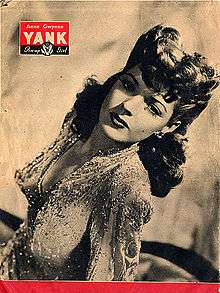Victory rolls
Victory rolls are a women's hairstyle that was popular from 1940 to 1945, characterized by voluminous curls of hair that are either on top of the head or frame the face. Victory rolls are closely associated with the pin-up look and are achieved using hairspray and various backcombing, rolling, pinning, and curling techniques.

The creator of the victory rolls is unknown, but several theories exist on the style's origins. The hairstyle has received a resurgence in popularity via themed parties and the swing dance scene.
History
Victory rolls were most popular during 1940 to 1945, during World War II.[1] Some theories exist as to the style's origin, the most commonly repeated of which are linked with World War II and the postwar movements. One theory associates victory rolls with the aviation aerobatic maneuver of planes that would spin horizontally as a sign of victory or celebration, as the style was supposed to resemble the movements of the air crafts.[2] Another associates it with the allies' victory over Germany, as it was symbolic of the women at home helping their loved ones fighting overseas.[3]
The style was popularized by film actresses such as Ingrid Bergman and the majority wore this style to frame their face so it fit the beauty standards of the day.[4] The style could be worn with two victory rolls or with a single roll. After 1945 the popularity of the victory rolls declined as the style was now to have the top of the head smooth, however some women still wore victory rolls on the sides of their head.[1]
Victory rolls have experienced a resurgence in vintage-era theme parties and in the swing dance scene.
Style
To achieve a victory roll women would use hairspray and various techniques such as backcombing, rolling, pinning, and curling so that rolls would either sit on the top of their head or frame their faces, as a woman with a thinner face could wear her hair in front of her ears so it would look wider.[5][6] Women with more disposable income would most likely go to the salon every day to get their hair done so they could achieve a shiny and slick look, whereas lower class women would have to do it themselves. Some women would also purchase wigs to avoid having to style their hair every day.[7]
References
- "1940s Hairstyles- History of Women's Hairstyles". vintagedancer.com. Retrieved 2020-04-06.
- "Hair Histories - Victory Rolls". Creative HEAD Magazine. 2019-05-09. Retrieved 2020-04-06.
- Hosanna (2011-02-18). "Happily Ever After: Why They're Called "Victory Rolls"". Happily Ever After. Retrieved 2020-04-06.
- Clayden, Kim. "European Hairstyles Through The Ages: 1916 - 2016". Culture Trip. Retrieved 2020-04-06.
- "BBC Three - Hair, Laura's Victory Rolls Hair Tutorial". BBC.
- Everyday, Vintage (2018-03-29). "Victory Rolls: The Hairstyle That Defined the 1940s Women's Hairdo". Vintage News Daily. Retrieved 2020-04-28.
- "1940s Hairstyles- History of Women's Hairstyles". vintagedancer.com. Retrieved 2020-04-06.